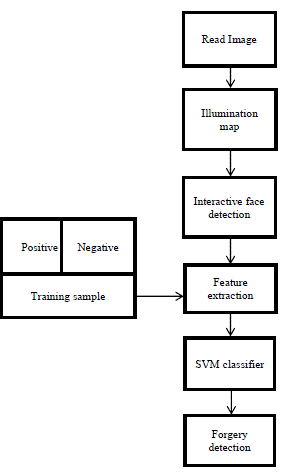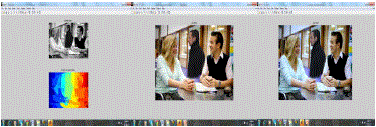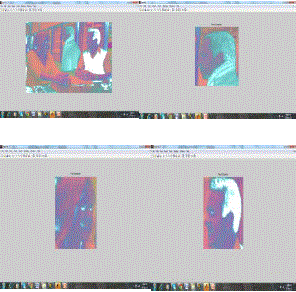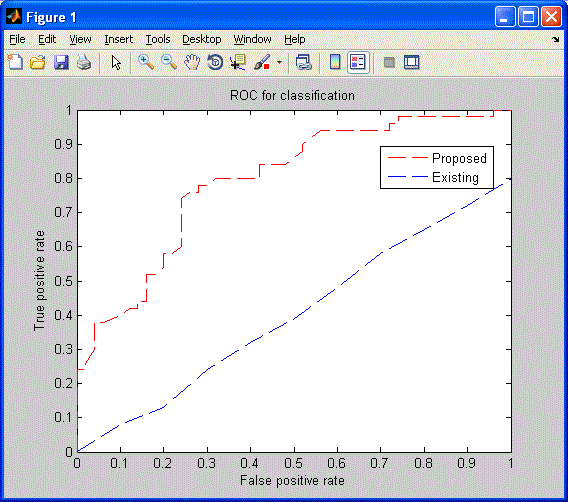Keywords
|
| Forgery, Neural Network, Illuminant color, Inverse intensity-chromaticity |
INTRODUCTION
|
| Forgery is the process of making adapting or imitating objects. Forgery consists of filling in blanks on a document containing a genuine signature, or materially altering or erasing an existing instrument. Instruments of forgery may include bills of exchange, bills of lading, promissory notes, checks, bonds, receipts, orders for money or goods, mortgages, discharges of mortgages, deeds, public records, account books, and certain kinds of tickets or passes for transportation or events.Methods of forgery include handwriting, printing, engraving, and typewriting. The related crime of uttering a forged document occurs when an inauthentic writing is intentionally offered as genuine. Some modern statutes include this crime with forgery. |
RELATEDWORK
|
| Forgery is the process of making, adapting objects. The different methods of forgery detection include examination, authentication and verification. Multiple methods of detection may be used to correctly identify single forgery. In [1] Lighting based digital forensic technique is used. The availability of sophisticated digital imaging technology has given rise to digital forgeries that are increasing in sophistication and frequency. This technique for exposing such fakes by detecting inconsistencies in lighting. High dynamic range image. It is often to difficult to match the lighting then two or more people are in composite nature, It has less sensitivity. In [2] Machinelearning classification approach is used. It is an efficient approach for simple image with one or two persons. It has Low detection rate. In [3] Gray world algorithm, gamut mapping algorithm are used. Gamut mapping method able toestimate the illuminant brightness. Computational complexity requires more data sets. In [4] Static method, Gamut based method, Learning based method are used. The static method algorithm applied at any image without any need of testing. This method does not depend upon training data, parameters depend upon the input data. Gamut based method, Learning based methods are needs to be trained before the illuminant can be estimated, parameter setting is fixed. Gamut based methods observes limited number of colors. In [5] Color consistency based algorithm is used. It deal with scenes containing multiple light sources, no human intervention is required. Performance of the segmentation is less than the clustering based approach. In [6]higher order gray edge algorithm is used. Computational complexity is less. It is caused by block-white edge. In [7] weighted gray edge algorithm is used. Edge based color constancy methods make use of image derivatives to estimate the illuminant. Different edge types exist in real world images, such as material, shadow and highlight edges. Controlled environments error can be reduce. Gray edge algorithm operated at any data. Uncontrolled environments maximum angular error increases. Misclassification of edge types the method may result in lesser performance. |
PROPOSED SYSTEM
|
| The main objective is to detect the forged images of people using the illuminant color. We propose a forgery detection method by using pixel illumination level algorithm is used for the detection purpose. Duplication is identified by matching each pixel in the image. We propose a Histogram of Oriented Gradient algorithm (HOG) is used for color illumination difference. Using our proposed learning approach we can attain high sensitivity. Support Vector Machine (SVM) is used for nonlinear data classification. Inverse intensity chromaticity color space is used to clarify color information and intensity.The process for forgery detection consists3 steps:-Illumination map, Interactive face detection, Featureextraction Training sample a,Positive,bNegative,SVM classifier. Illuminant map is done to obtain similar pixel in an image. It applies a specific color in an image the pixels with approximately similar values are displayed in same color. By this method large varying pixels are easily identified Dealing with RGB image is a difficult task for this purpose RGB value is converted to gray scale value. This conversion reduces the computational complexity. Because if the foreground and background image is same it will be brightly displayed in gray scale. Gray scale is a range of shades of gray without apparent color. The darkest possible shade is block, which is the total absence of transmitted or reflected light. The lightest possible shade is white. Face detection is an important task in forgery detection Principle Component Analysis Algorithm is applied for this purpose.SVM classifier is employed for accurate detection of forgery an image. This method can detect forgery at any illumination level. |
MODULE DESCRIPTION
|
| Illumination map: An image is divided into blocks. In every block contains pixels. Color will be applied in the image, near to pixel range same color will be displayed. Pixel with different range is displayed with different color. An illuminant color is locally estimated using the pixel. This process is called graph cut segmentation. |
| RGB is converted into gray scale. Because if the foreground and background image is same it will be brightly displayed in gray scale. Gray scale is a range of shades of gray without apparent color. The darkest possible shade is block, which is the total absence of transmitted or reflected light. The lightest possible shade is white. In segmenting image by pixel classification, the sequence of gray levels of the pixels neighbors can be used as a feature vector. |
| Interactive face detection: Face detection is an important application in forgery detection. In this project Principle component analysis algorithm is well suited for face recognition. For this purpose the database is required and is created from the images. The images used for forgery detection are of m pixels high and n pixels wide. An image vector is determined from the database. Using this vectors a matrix form is generated which gives the starting point for principle component analysis algorithm. From the matrix form covariance are determined and the eigen vectors are found for the original images. |
| Feature extraction: This step is to extract the face from the images and it requires human interaction. Set a boundary box with each faces. Crap every boundary box out of each illuminant map SVM Classifier: In this paper Support Vector Machine (SVM) classifier is used for accurate detection of forgery. Two-class SVM classifier is used to obtain the distance between the image’s vectors and the decision boundary. This classifier is employed to independently classify each combination of illuminant map and feature type. Marginal distances provided by all m individual classifiers are merged to build a new feature vector and this is done using SVM-Meta Fusion. |
RESULT
|
| Theproposed method is to detect forgery in images. Pixel illumination algorithm is used for detection purpose. This method requiresonlyaminimum amountofhumaninteraction. Histogram of Oriented Gradient algorithm (HOG) is used for measuring color illumination difference. It can detect forgery at any illumination level with high accuracy.SVM classifier is employed to detect forgery. |
| The performance measures are calculated for some parameters such as accuracy, fault detection etc.In this paper accuracy is calculated for existing and proposed system and is shown below In this paper accuracy of detecting forgery is enhanced by using SVM classifier. Fault detection is minimized |
CONCLUSION AND FUTURE WORK
|
| Forgery is an illegal modification or reproduction of an image, document signature, legal tender or any other means of recording information. So it is an important task to detect forgery in real time application. Several techniques are employed for detecting such forgeries. In this paper forgery is detected by using SVM classifier. Itminimizes human interaction and efficiently detect forgery at any illumination level. |
| Forgery is an illegal modification or reproduction of an image, document signature, legal tender or any other means of recording information. With the improvement in technology several forgeries are happening. So some forgery detection technique must be handled with new techniques. In the proposed system SVM classifier is employed for forgery detection. This system provides efficient forgery detection in various illumination changes. In future it is extended to achieve high performance. Furtherimprovementscanbeachieved whenmore advancedilluminantcolor estimatorsbecomeavailable. This system can be improved by using Neuro fuzzy, GeneticAlgorithm, Wavelettransform, and fuzzy logic. |
| |
Figures at a glance
|
 |
 |
 |
 |
 |
| Figure 1 |
Figure 2 |
Figure 3 |
Figure 4 |
Figure 5 |
|
| |
References
|
- M.Johnsonand H.Farid, “exposing digital forgeries in complex lighting environments,” IEEETrans.Inf. Forensics Security, vol.3, no.2, pp.450–461, Jun.2007
- P.Saboia, T.Carvalho, and A.Rocha, “Eye Specular highlights telltales for digital forensics: Machine Learning approach,” inProc. IEEEInt. Conf. Image Processing (ICIP), 2011, pp. 1937–1940.
- K.Barnard V.Cardei, and B.Funt, “A Comparison Of Computational Color Constancy Algorithms–Part Methodology and Experiments With Synthesized Data,” IEEE Trans. Image Process., vol.11, no.9, pp.972–983, Sep.2002.
- A.Gijsenij, T.Gevers, and J.vandeWeijer, “computational color constancy survey and experiments, ”IEEETrans. ImageProcess., vol.20, no.9, pp.2475– 2489, Sep.2011.
- A.Gijsenij, R.Lu, and T.Gevers, “Color constancy for multiple light sources, ”IEEETrans. Image Process., vol.21, no.2, pp.697–707, Feb. 2012.
- J.vandeWeijer, T.Gevers, and A.Gijsenij, “Edge based color constancy, ”IEEETrans. Image Process. vol.16, no.9, pp.2207–2214, Sep.2007.
- G.Buchsbaum,“Aspatial process or model for color perception,”J. FranklinInst., vol.310, no. 1,pp.1–26,Jul. 1980
|